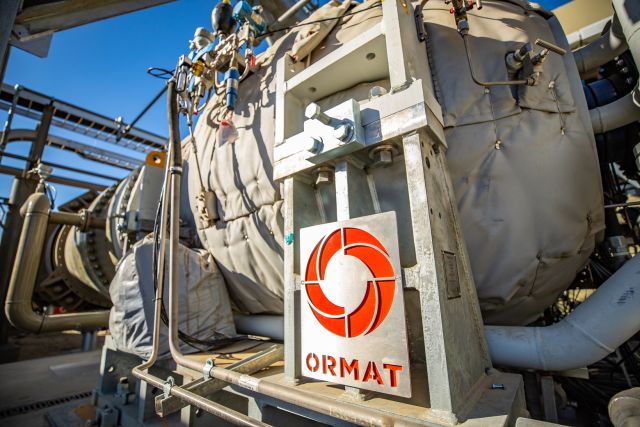
Ormat Technologies brought the North Valley geothermal power plant online in Nevada in 2023. (Source: Ormat Technologies)
Global geothermal, solar and storage player Ormat Technologies says it aims to double its portfolio capacity to at least 2.6 gigawatts (GW) by year-end 2028.
Currently, the Nevada-based company—which recently formed a geothermal partnership with SLB—has 10 geothermal, three solar and seven energy storage projects under development. Ormat is mostly focused on U.S. growth as the nation adds more renewable energy and battery energy storage systems to grids amid regulatory moves to speed up permitting.

“As such targets suggest, we currently expect we will see an annual growth rate between 15[%] and 17%, with the majority of this growth focused in the U.S.,” Ormat CEO Doron Blachar said Aug. 7 during the company’s second-quarter earnings call. “While we see plenty of promising opportunities internationally, the U.S. has become a much larger focus for our growth effort given the rapidly increasing opportunities in the region for both our electricity and storage segments.”
The Biden-Harris administration has its sights set on 100% clean electricity by 2035 and a zero-emissions economy by 2050 in an effort to lower greenhouse gas emissions. Bolstering renewable and low-carbon energies, including by encouraging development with tax incentives, have been a key part of the plan.
Ormat, which reported quarterly revenues increased year-over-year by 9.3% to $213 million, is gearing up to bring several projects online in the coming years in the U.S. and abroad.
Geothermal
In second-quarter 2024, Ormat launched its 6-megawatt (MW) Beowawe geothermal power plant upgrade in Nevada.
Following Beowawe’s startup, Ormat said it expects to begin commercial operations of the 15-MW Ijen geothermal project in Indonesia in fourth-quarter 2024.
The company plans to start commercial operations at the Cove Fort (Utah), Still Water (Nevada) and Salt Wells (Nevada) geothermal sites in the U.S. by year-end 2025 and bring the Puna expansion (Hawaii) and North Valley 2 (Nevada) geothermal projects into commercial operation in second-half 2026.
“We continue to remain encouraged by the growing demand for geothermal, which would allow us to maintain strong backlog,” Blachar said.
Solar
Ormat said it plans to start up the Beowawa Solar project in early 2025 when a power purchase agreement kicks in. The 42-MW Arrowleaf facility in California is expected to begin commercial operations in first-half 2025, while the 14-MW McGinness Hills Solar is set to come online in second-half 2026.
Energy storage
The company expects the 320-megawatt hour (MWh) Bottleneck project in California to go online by the end of September—a part of Ormat’s efforts to strengthen its energy storage operations.
“In total, we currently have seven different storage projects under development that we expect to achieve COD [commercial operation date] by the end of 2026, which would add a total of 435 megawatts, 1,240 megawatt hours [to the] storage portfolio,” Blachar said.
Energy storage projects scheduled to begin commercial operations in the first half of 2025 include the 20-MW Montague in New Jersey and the 60-MW Lower Rio in Texas. They are expected to be joined by the 35-MW Arrowleaf in California, 60-MW Bird Dog in Texas and the 80-MW Shirk in California in the second half of 2025.
The 100-MW capacity Luisa storage development in Texas could begin operations at the end of 2026.
Tailwinds to drive profitability
All of the storage projects stand to benefit from investment tax credits (ITCs) ranging from 30% to 40%. ITCs and other federal tax incentives have played a role in renewable energy companies’ decisions to pursue projects in the U.S.
Blachar called the U.S. Senate’s recent introduction of the Energy Permitting Reform Act a positive, saying it seeks to “ease the environmental review for solar wind and geothermal projects in ways the oil and gas industry has long enjoyed.” If the bill becomes law, it could not only accelerate permitting timelines needed to advance geothermal exploration and solar projects, it could also “put us in an even stronger position to reach and exceed our long-term operating capacity goal,” he said.
With nearly 35 named prospects, Ormat said it has about 3.5 GW of potential U.S. storage pipeline capacity. More than 2 GW of that is in California.
“As we look ahead, we continue to see strong industry tailwinds for both geothermal and energy storage that will help drive profitability for Ormat, and the demand for electricity continues to grow with the rise of data centers,” Blachar said. “With all this combined, we believe that we are on the right path forward to drive significant stakeholder value in 2024 and beyond.”
Recommended Reading
Six New Dean Wildcats Come With 95% Oil in Northern Midland Basin
2025-02-21 - SM Energy reported geologic variability in deposition in the new play in southern Dawson County, Texas, but “it's really competitive.”
Enchanted Rock’s Microgrids Pull Double Duty with Both Backup, Grid Support
2025-02-21 - Enchanted Rock’s natural gas-fired generators can start up with just a few seconds of notice to easily provide support for a stressed ERCOT grid.
Michigan Appeals Court Allows Enbridge’s Line 5 Permits to Stand
2025-02-21 - Enbridge’s Line 5 still faces a court battle against the state in a case brought by the government.
Energy Transition in Motion (Week of Feb. 21, 2025)
2025-02-21 - Here is a look at some of this week’s renewable energy news, including a record for community solar capacity in the U.S.
Dividends Declared Week of Feb. 17
2025-02-21 - 2024 year-end earnings season is underway. Here is a compilation of dividends declared from select upstream, midstream, downstream and service and supply companies.
Comments
Add new comment
This conversation is moderated according to Hart Energy community rules. Please read the rules before joining the discussion. If you’re experiencing any technical problems, please contact our customer care team.






